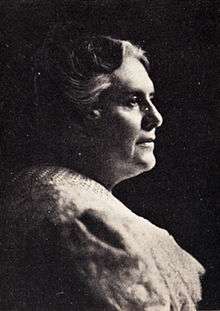Anna Botsford Comstock
| Anna Botsford Comstock | |
|---|---|
 | |
| Born |
1 September 1854 Otto, New York, U.S. |
| Died |
24 August 1930 (aged 75) Ithaca, New York, U.S. |
| Nationality | American |
Anna Botsford Comstock (September 1, 1854 – August 24, 1930) was an American artist, educator, conservationist, and a leader of the nature study movement, born in Otto, New York, to Marvin and Phebe Irish Botsford.
Comstock grew up on her parents' farm, where she and her Quaker mother spent time together examining the wildflowers, birds, and trees.
Comstock attended the Chamberlain Institute and Female College, a Methodist school in Randolph, New York, then she returned to Otto and taught for a year.
In 1874, Comstock entered Cornell University in Ithaca, New York where she was a member of Kappa Alpha Theta. She left Cornell after two years. In 1878, at the age of 24, she married John Henry Comstock, a young entomologist on the Cornell faculty who got her interested in insect illustration.[1]
Throughout her life, Comstock illustrated her husband's lectures and publications on insects. She had no formal training in this illustration; she would study an insect under a microscope then draw it. While her husband was chief entomologist in the U.S. Department of Agriculture from 1879 to 1881, she prepared the drawings for his 1880 Report of the Entomologist on citrus scale insects. She then reentered Cornell and received a degree in natural history in 1885. Then she studied wood engraving at Cooper Union, New York City, so she could prepare illustrations for her husband's book Introduction to Entomology in 1888. Also in 1888, she was one of the first four women admitted to Sigma Xi, a national honor society for the sciences.[2]
Comstock made engravings for the more than 600 plates Manual for the Study of Insects (1895), Insect Life (1897), and How to Know the Butterflies (1904),[3] the first written by her husband and the latter two co-authored by them. Her engravings were also featured in exhibits and won several prizes. She both wrote and illustrated several books, including Ways of the Six-Footed (1903),[4] How to Keep Bees (1905), The Handbook of Nature Study (1911), The Pet Book (1914),[5] and Trees at Leisure (1916).[6] She also wrote the novel Confessions to a Heathen Idol (1906).[7][8] Liberty Hyde Bailey and her husband told her they expected The Handbook of Nature Study to lose money, but it became a standard textbook for teachers and was later translated into eight languages, with over twenty printings. It is still in print.[9]
Comstock is most famous for being one of the first to bring her students and other teachers out-of-doors to study nature. In 1895, Comstock was appointed to the New York State Committee for the Promotion of Agriculture. In this position, she planned and implemented an experimental course of nature study for the public schools. The program was approved for statewide use through the extension service of Cornell. She then wrote and spoke on behalf of the program, helped train teachers, and prepared classroom materials. Starting in 1897, she taught nature study at Cornell. Comstock was the first female professor at Cornell. However, she was denied full professorship for twenty years until 1920. (In 1911, Martha Van Rensselaer and Flora Rose became the first women with full professorship at Cornell.)
Comstock edited Nature-Study Review from 1917 to 1923, and she was on the staff of Country Life in America.
Anna Botsford's autobiography was published in 1953 by Comstock Publishing Associates (Ithaca, NY), titled "The Comstocks of Cornell: John Henry Comstock and Anna Botsford Comstock".
In 1922, Comstock retired from Cornell as professor emerita but continued to teach in the summer session. In 1923, she and Martha Van Rensselaer were nominated by the National League of Women Voters as being among the twelve greatest women in the country.
Comstock died in Ithaca, New York in 1930.[2] In 1988, she was inducted into the National Wildlife Federation Conservation Hall of Fame.
References
- ↑ Golemba, Beverly E. (1992). Lesser-Known Women: A Biographical Dictionary. Boulder u.a.: Rienner. p. 157. ISBN 978-1-55587-301-1.
- 1 2 Brandt, William (2009). Interpretive Wood-Engraving: The Story of the Society of American Wood-Engravers. New Castle, Delaware: Oak Knoll Press. p. 108. ISBN 978-1-58456-267-2.
- ↑ Comstock, John Henry and Anna Botsford (1904). How to Know the Butterflies. New York: D. Appleton and Co. Retrieved July 30, 2016.
- ↑ Comstock, Anna Botsford (1903). Ways of the Six-Footed (First ed.). Boston: Ginn & Company. Retrieved July 30, 2016.
- ↑ Comstock, Anna Botsford (1914). The Pet Book (Second ed.). Comstock Publishing Company. Retrieved July 30, 2016.
- ↑ Comstock, Anna Botsford (1916). Trees at Leisure. Ithaca, New York: Comstock Publishing Co. Retrieved July 30, 2016.
- ↑ Comstock, Anna Botsford (1909). Confessions to a Heathen Idol. Garden City, New York: Doubleday, Page & Co. Retrieved July 30, 2016.
- ↑ Comstock, Anna Botsford (1911). Confessions to a Heathen Idol. Garden City, New York: Doubleday, Page & Co.
- ↑ Comstock, Anna Botsford (1986). Handbook of Nature Study (First with a Foreword by Verne N. Rockcastle ed.). Ithaca, New York: Comstock Associates/ Cornell University Press. ISBN 978-0-8014-9384-3. Retrieved July 30, 2016.
External links
- Works by or about Anna Botsford Comstock at Internet Archive
- Works by Anna Botsford Comstock at LibriVox (public domain audiobooks)

- Digitised books and articles by Anna Botsford Comstock at Biodiversity Heritage Library
- 1923 Letter to Martha Van Rensselaer at Cornell University Rare and Manuscripts Collections